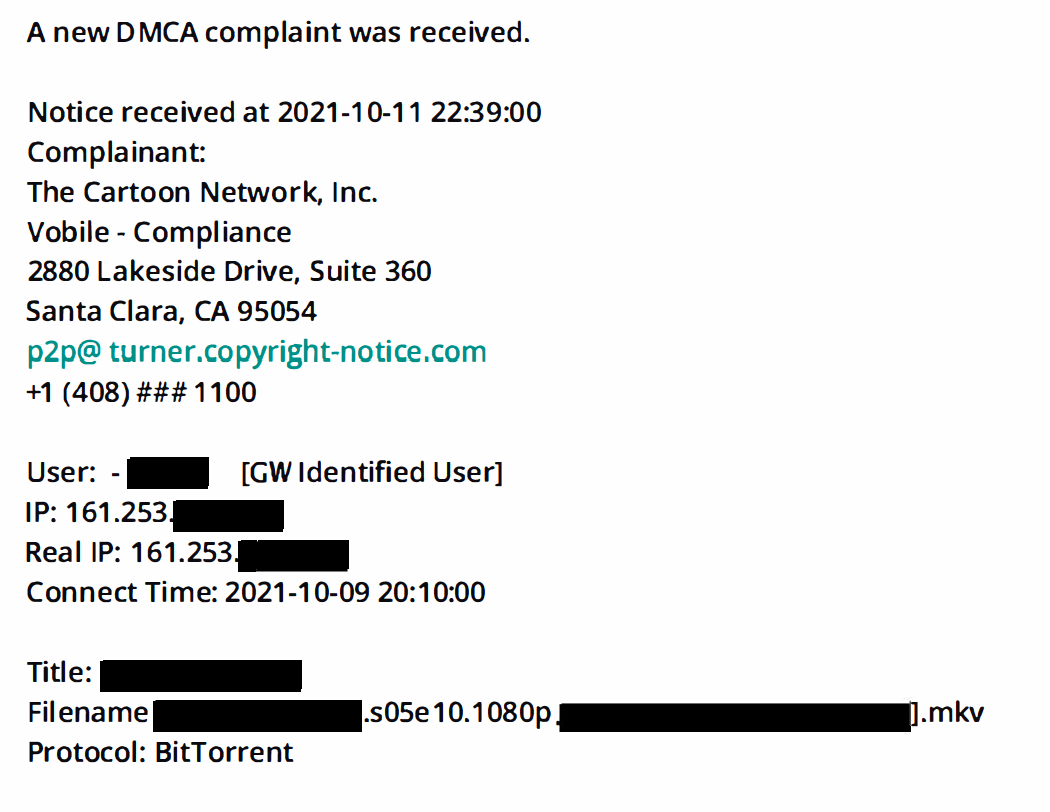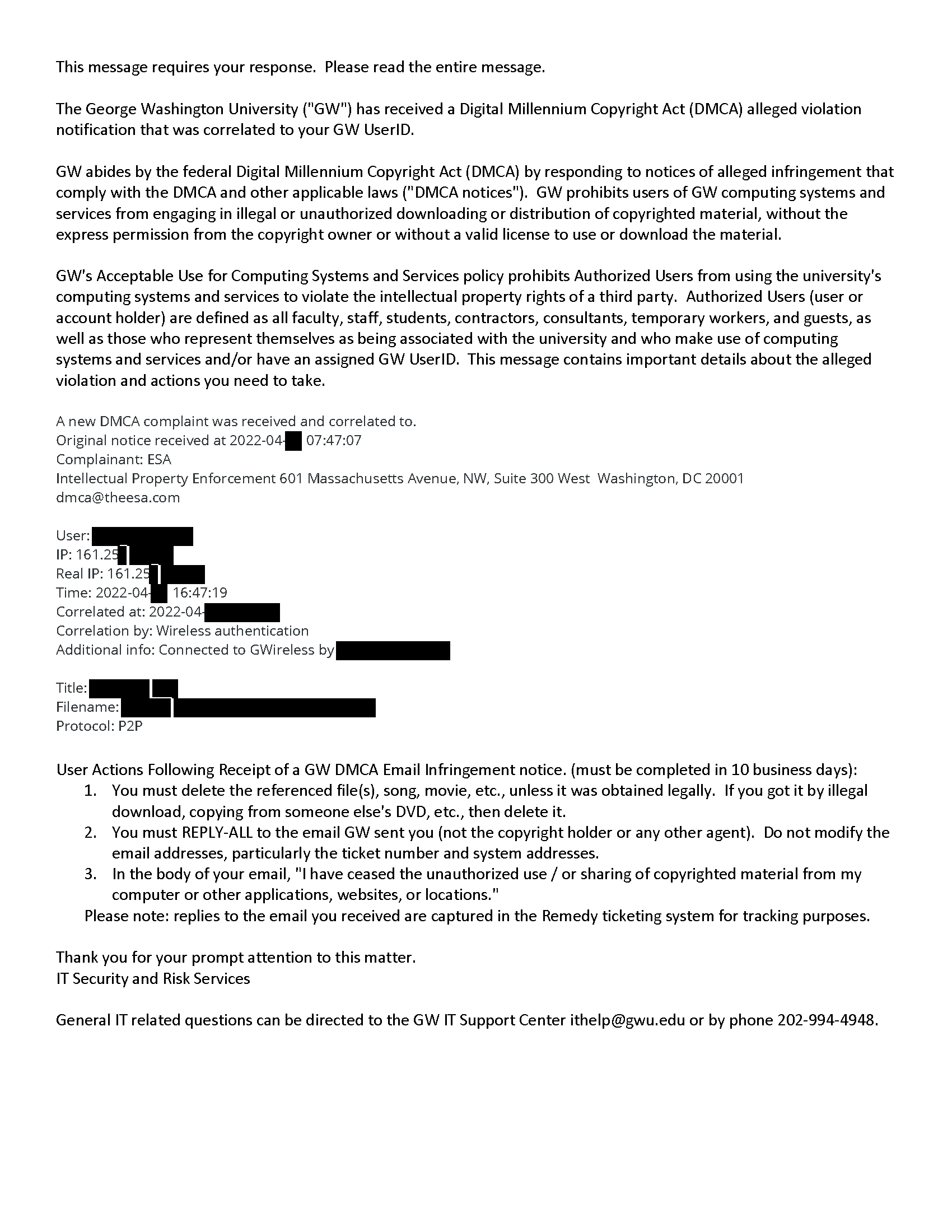Digital Millennium Copyright Act
All George Washington University including faculty, staff, contractors, and guests must adhere to specific GW policies and various codes of conduct related to their university role. GW’s investments in network resources and internet access enabling this flow of information is possible in part because of the legal protections provided by the federal Digital Millennium Copyright Act of 1998 (DMCA).
GW policy prohibits members of the university community from engaging in the unauthorized distribution or receipt of copyrighted material. This prohibition includes the use of peer-to-peer file sharing programs or other technologies to download, upload or otherwise transfer copyrighted music, video and other material using GW's computer network.
Potential consequences of unauthorized copy and distribution of intellectual property or other violations of GW's Acceptable Use of IT Resources Policy include losing access to the university network, being referred to the Office of Student Rights & Responsibilities, Human Resources or Faculty Personnel for disciplinary action and/or direct legal action from the copyright owner. All university users are reminded that unauthorized distribution of copyrighted material may bring civil and criminal penalties.
Frequently Asked Questions - FAQs
- How are violations of the Digital Millennium Copyright Act (DMCA) discovered?
Copyright holders monitor their materials on the web and alleged illegal downloads of those materials. GW does not actively monitor for copyright violations.
- What happens when a copyright holder identifies a GW network-connected device or GW user is accessing copyrighted material?
Any potential copyright infringement discovered by a copyright holder can result in notifications including sending GW a DMCA Notice of Copyright Infringement or ‘Take Down Notice’.
- Why are these notices sent to GW and not the alleged violator directly?
Alleged copyright violations when discovered contain the internet protocol (IP) address of the computer sharing or downloading the materials. As GW is effectively an internet service provider (ISP) that provides users access to the internet, GW receives notifications identified as being within GW’s IP address ranges. In other words, GW is providing the alleged violator an internet connection.
- How is the ‘Take Down Notice’ received by GW?
The takedown notice is delivered by email sent to gwdmca@gwu[.]edu. Notices sent to this address are processed by GW Information Technology to correlate information provided in the notice to GW network and user details. Identifying the alleged user is necessary for GW to fulfill its obligations.
- How will I know if a notice was received by GW related to my network-connected devices or my GW's UserID?
Based on information in the alleged copyright notice and additional user or computer details discovered by GW Information Technology (GW IT), alleged violators will be contacted by email from a ticketing system account ‘GW Support’ (DIVIT-Remedy@gwu[.]edu). This email will provide the details of the alleged infringement as well as detailed instructions that need to be followed to resolve the alleged. The email subject for this email will also contain a reference number WO00000###### - to uniquely identify the tracking ticket followed by either ‘Splunk Alert: DMCA notification received’ or ‘DMCA Notification Received’. The body of the message will have a header ‘Remedy with SmartIT’ above the actual message concerning the alleged violation. Sample alleged violation notice.
- Why are these alleged violations tracked in a ticketing system?
Tracking alleged violations assists GW with compliance requirements of the DMCA. Using a ticket system enhances the ability to capture and retain communications about an alleged violation and its disposition. In the rare event that an alleged violation needs to be escalated for potential disciplinary action, the ticketing system provides background details and communications.
- Can you provide an example of a DMCA Notice of Copyright Infringement GW might receive?
Yes. The screenshot is an example of a DMCA notice, and includes information about the violation and location of the content in question.
- Can you provide an example of a DMCA Notice of Copyright Infringement that will be sent from GW IT?
Yes. The following image is an example of the DMCA Notice that will be sent from GW IT to the UserID associated with the violation. The message will include information about potential infringement and GW's acceptable use policy. Information about the content in question, and required actions will also be included in the message.
- What if I do not reply to the GW originated email about the DMCA Notice of Copyright Infringement or do not follow the instructions in the message?
Your network access may be restricted or blocked until you have responded to the notification following the instructions in the notice you received. Additionally, you may face sanctions by appropriate offices for disciplinary action and/or legal action from the copyright owner.
- What other options do I have regarding an alleged violation of copyright?
You do have other options that you can pursue, but the cessation and confirmation of ceasing any alleged copyright violation activity is a necessary first step. Additional information about additional processes and rights can be found in these frequently asked questions.
- Where can I go to learn more about the Digital Millennium Copyright Act (DMCA)?
The U.S. Copyright Office describes the DMCA on copyright.gov as follows:
In 1998, Congress passed the Digital Millennium Copyright Act (DMCA), which amended U.S. copyright law to address important parts of the relationship between copyright and the internet. The three main updates were: (1) establishing protections for online service providers in certain situations if their users engage in copyright infringement, including by creating the notice-and-takedown system, which allows copyright owners to inform online service providers about infringing material so it can be taken down; (2) encouraging copyright owners to give greater access to their works in digital formats by providing them with legal protections against unauthorized access to their works (for example, hacking passwords or circumventing encryption); and (3) making it unlawful to provide false copyright management information (for example, names of authors and copyright owners, titles of works) or to remove or alter that type of information in certain circumstances.- Can the connection between the DMCA, my GW network use, and GW UserID, email, or computer be explained?
The Digital Millennium Copyright Act (DMCA) was updated in 1998 to provide the legal framework for copyright holder claims of copyright infringement in the digital world. Specifically, a university functions as an Internet Service Provider (ISP) (e.g., a cable company, telephone company, college, university, etc.). As a result of a university providing internet access to users, it has the records necessary to match an Internet Protocol (IP) address and time stamp to an individual. The DMCA tries to balance the needs of copyright holders whose digital works can be rapidly, perfectly, and infinitely copied and the liability of an ISP for its users’ infringing activity, all in the context of protecting intellectual property to promote innovation. GW IT only seeks to correlate network activity when an alleged violation notice is received. The limited activity that automated scripts perform is an association of the GW internet protocol addresses (IP) provided by the notification along with the specific date and time of the alleged violation with user network access data at the same time. This correlation is only performed on IP addresses provided in alleged copyright violation notices.
Copyright holders are responsible for identifying activity that infringes on their works and sending a DMCA claim to the ISP from which the alleged infringement came. The ISP must follow certain procedures (for example, registering a Designated Agent with the US Copyright Office) if it wishes to avail itself of the safe harbors afforded by the DMCA. (material for this answer was excerpted from educause.edu)
- What other regulations are related to the DMCA, GW, and network users?
“In 2008, the Higher Education Opportunity Act (HEOA) added obligations to higher education institutions with respect to combating illegal peer-to-peer (P2P) file-sharing. In some cases, these additional obligations codified as federal regulatory requirements what institutions were already doing by policy choice. Unlike the DMCA, the HEOA requirements are mandatory and its provisions only apply to higher education institutions (i.e., not all ISPs).”
This FAQ answer came from educause.edu- In addition to processing notices of copyright infringement, what other actions does GW use to protect copyright?
GW network resources including bandwidth are shared by all users for academic, research, social and administrative purposes. As illegal P2P file sharing, uploading, and downloading of copyrighted materials, consume large amounts of this shared resource, excessive bandwidth consumption may result in bandwidth reductions for P2P applications. This process is known as ‘bandwidth shaping’ or bandwidth throttling. GW also restricts P2P applications and limits bandwidth usage for large file transfers on its Guest wireless or other similar resources.
- Are there more details available about how GW processes DMCA Notice of Copyright Infringement?
- Alleged Violation sent by the copyright owner to GW.
- GW processes the notification.
- GW sends details of the alleged violation to the identified user.
- The GW identified user must delete any copyrighted materials and include a statement in return email the following statement – “I have ceased the unauthorized use / or sharing of copyrighted material from my computer or other applications, websites, or locations."
- If steps 1-4 occur within 10 business days of notification, the issue will be closed. Failure to follow the steps may result in additional actions.
- Where can I access online content legally?
EDUCAUSE provides a list of Legal Sources of Online Content at educause.edu
- How do I learn even more about copyright?
The U.S. Copyright Office website has several copyright-related video tutorials available at their site. The following list of tutorials and resource links are organized by subject areas. These resources including additional descriptions are available online at copyright.gov in August 2021. This official page also has links to other resources and references grouped by the categories and subject areas noted below.
- How does GW communicate information about the Digital Millennium Copyright Act (DMCA)?
This website is an example of our efforts to educate the university community about accessing digital content and copyright. Additionally, references to the process are shared periodically through GW Info Mail messages. Various units include details on acceptable technology and network use in their onboarding materials and all policies and codes of conduct contain references to adhering to federal law and GW's Acceptable Use of IT Resources Policy.



